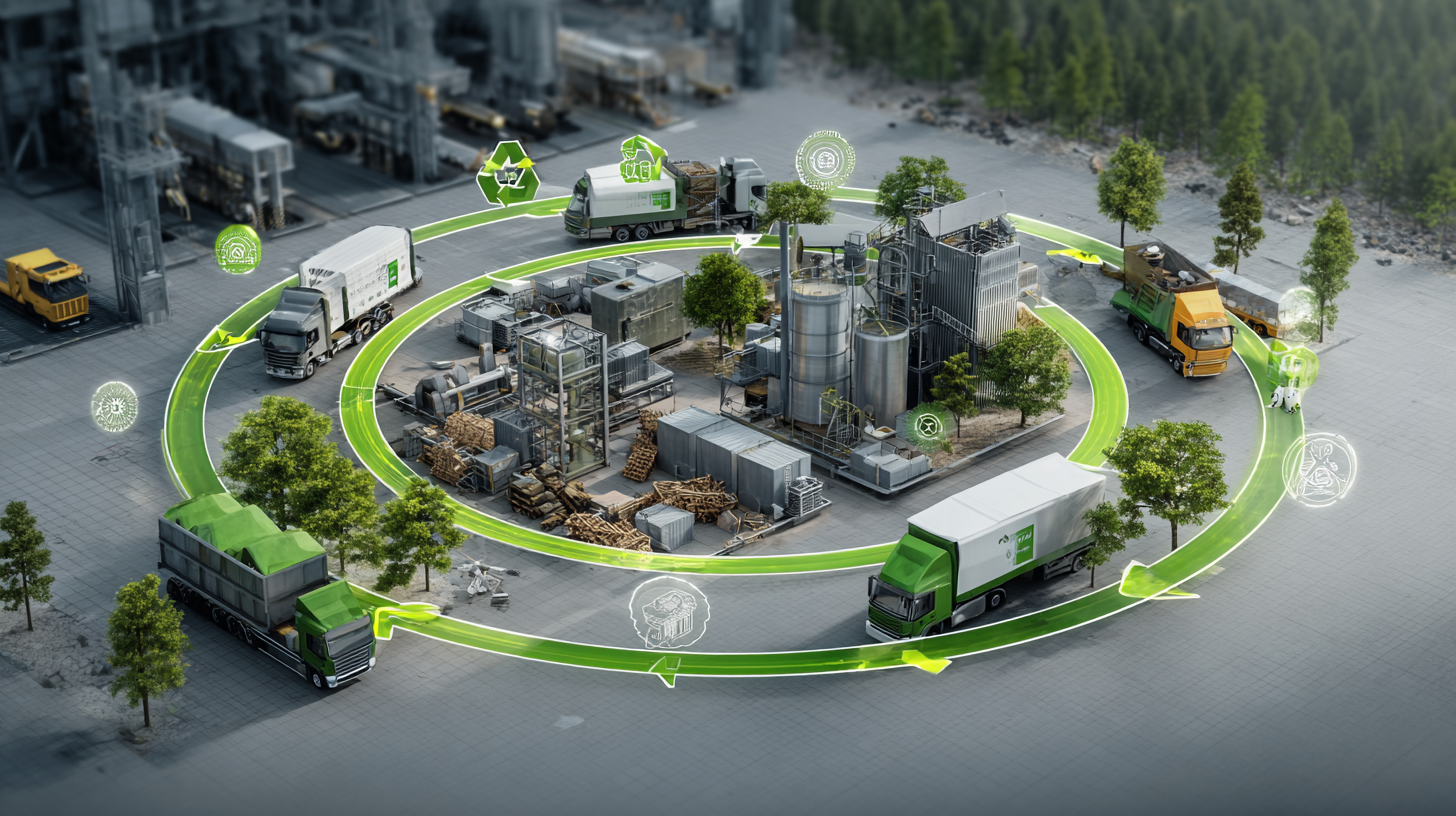As the global economy confronts the pressing challenges of resource depletion and environmental degradation, the concept of a Circular Economy is increasingly emerging as a transformative approach to sustainable development. According to a report by the Ellen MacArthur Foundation, transitioning to a circular model could generate $4.5 trillion in economic benefit by 2030, highlighting the potential for sustainable practices to drive innovation and economic growth.

Companies are redefining their operations by adopting innovative strategies that prioritize resource efficiency, product longevity, and waste reduction. For instance, the Global Reporting Initiative (GRI) indicates that businesses implementing circular economy principles can reduce greenhouse gas emissions by up to 70% in certain sectors.
This exploration into the future of the Circular Economy reveals not only the necessity of sustainable practices but also the vast opportunities for businesses and society to thrive in harmony with the planet.
The principles of the circular economy (CE) are fundamentally transforming traditional business practices, emphasizing sustainability and resource efficiency. Unlike the conventional linear economy that follows a "take-make-dispose" model, the circular economy encourages the continual use of resources through designs that promote reuse, remanufacturing, and recycling. According to the Ellen MacArthur Foundation, embracing circular economy practices could unlock economic benefits of $4.5 trillion by 2030, highlighting the urgent need for industries to shift towards sustainable innovation.
Sustainable innovation within the circular economy goes beyond mere material efficiency; it involves redesigning products and services to minimize waste. Research shows that 90% of resource consumption occurs in the design phase, indicating that integrating circular principles at this stage can significantly impact sustainability outcomes. Companies are increasingly adopting innovative practices such as modular design and take-back schemes, which not only enhance product lifespan but also engage consumers in the sustainability narrative. The Global Initiative for a Sustainable Future reported that businesses implementing circular strategies have seen a 15-20% decrease in operational costs, exemplifying how economic gain and environmental responsibility can go hand in hand.
 In the transition to a circular economy, identifying key players and stakeholders is crucial for fostering collaboration and driving sustainable practices. Businesses, governments, non-profit organizations, and consumers all play vital roles in this ecosystem. Companies implementing circular strategies can lead the charge by adopting sustainable materials, enhancing product lifecycle management, and optimizing waste reduction techniques. Equally important are policymakers, who create frameworks and incentives that encourage businesses to commit to circular principles, while consumers drive demand for sustainable products.
In the transition to a circular economy, identifying key players and stakeholders is crucial for fostering collaboration and driving sustainable practices. Businesses, governments, non-profit organizations, and consumers all play vital roles in this ecosystem. Companies implementing circular strategies can lead the charge by adopting sustainable materials, enhancing product lifecycle management, and optimizing waste reduction techniques. Equally important are policymakers, who create frameworks and incentives that encourage businesses to commit to circular principles, while consumers drive demand for sustainable products.
Tips: Engage with local businesses to explore collaborative opportunities for recycling and upcycling initiatives that benefit the community. Moreover, consider utilizing tools and platforms that connect stakeholders involved in the circular economy, fostering innovation and information sharing across industries.
Another essential player in this ecosystem is academia, where research and development of new circular technologies occur. Educational institutions can collaborate with industries to not only advance technological solutions but also to promote awareness and training around circular economy practices. Community organizations also play a role by advocating for sustainable policies and practices at the grassroots level, ensuring that the voices of consumers and local stakeholders are heard.
Tips: Attend workshops or webinars focused on circular economy principles to expand your understanding and network with like-minded stakeholders. Working in partnerships can amplify efforts and drive substantial change in your region.
In recent years, the circular economy has emerged as a pivotal model for advancing sustainability across various industries. Innovative technologies play a crucial role in supporting circular practices, transforming traditional linear processes into systems that prioritize resource efficiency and waste reduction. For instance, advancements in material science have enabled the development of biodegradable alternatives to conventional plastics, which not only minimize environmental impact but also allow for compostable applications across multiple sectors.

Moreover, the integration of digital technologies such as the Internet of Things (IoT) and artificial intelligence (AI) is revolutionizing how businesses approach resource management. Through real-time monitoring and data analysis, companies can optimize their supply chains, reduce material waste, and extend product lifecycles. Industries such as fashion and manufacturing are already harnessing these technologies to implement closed-loop systems, where products are designed for reusability and recycling, thus fostering a more sustainable economic model. As these innovative practices continue to gain traction, they pave the way for a more resilient and environmentally conscious future.
The transition to circular business models necessitates the implementation of effective strategies that prioritize sustainability and resource efficiency. Businesses must first assess their existing processes to identify areas ripe for transformation. This involves rethinking product life cycles and integrating principles of reuse, repair, and recycling. By leveraging renewable materials and adopting eco-design practices, companies can significantly minimize waste while maximizing resource value. Collaboration with suppliers and consumers is crucial in this phase, as it fosters innovation and drives collective efforts towards a circular economy.
Moreover, education and stakeholder engagement play vital roles in facilitating this transition. Organizations should invest in training programs that equip employees with the knowledge and skills needed to adopt circular practices. Additionally, engaging customers can help build a shared understanding of sustainability goals, encouraging responsible consumption habits. By creating a transparency-focused culture, businesses can enhance customer loyalty and drive demand for sustainable products. In this evolving landscape, aligning business strategies with sustainability imperatives will not only yield competitive advantages but also contribute to a more resilient and responsible economy.
This chart illustrates the projected adoption rates of various innovative sustainable practices in the transition to circular business models over the next five years.
In the realm of the circular economy, measuring success is essential to assess the impact of innovative sustainable practices. Metrics and assessments play a pivotal role in identifying which strategies effectively minimize waste, conserve resources, and promote sustainable growth. Businesses must establish clear, quantifiable goals that align with circular principles. Common metrics include waste reduction percentages, resource recovery rates, and lifecycle assessments that provide insights into the environmental impact of products from creation to disposal.
Tip: Regularly audit your sustainability initiatives. Conducting assessments every few months can help pinpoint areas for improvement and ensure your goals remain relevant and achievable.
Beyond traditional metrics, embracing qualitative assessments can provide a deeper understanding of stakeholder engagement and community impact. Surveys and feedback mechanisms can reveal how consumers perceive and interact with circular practices, offering insights that quantitative data may overlook. Integrating both quantitative and qualitative metrics allows businesses to create a holistic view of their circular economy efforts, driving continuous improvement and success.
Tip: Engage with your stakeholders actively. Forming partnerships with educational institutions, NGOs, or even competitors can foster innovative ideas and enhance your sustainability metrics through shared knowledge.
| Sustainable Practice | Metric | Assessment Method | Success Indicator |
|---|---|---|---|
| Recycling Initiatives | Percentage of Materials Recycled | Annual Recycling Audit | Increase in Recycled Materials by 15% |
| Green Product Design | Lifecycle Assessment Score | Third-Party Lifecycle Analysis | Score Improvement from 65% to 85% |
| Energy Efficiency Programs | Energy Consumption Reduction | Energy Audits and Monitoring | Reduction of 20% in Energy Usage |
| Waste Minimization Techniques | Waste Diversion Rate | Monthly Waste Tracking | Achieving 75% Waste Diversion |
| Sustainable Supply Chain Practices | Supplier Compliance Rate | Supplier Audits | Over 90% Supplier Compliance |






